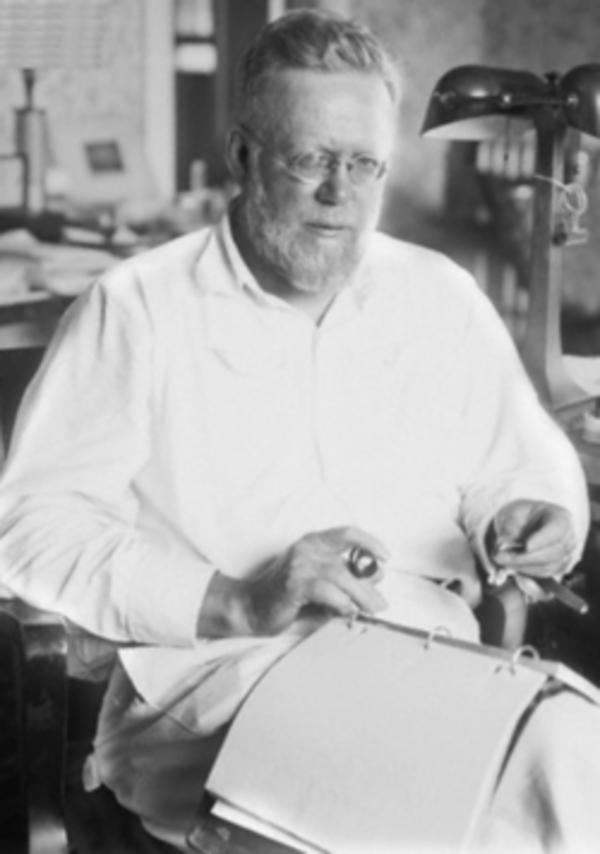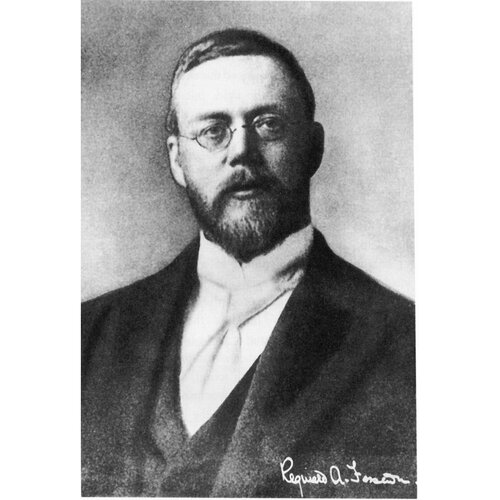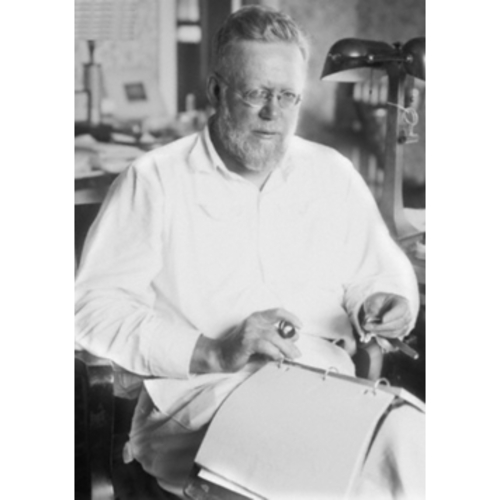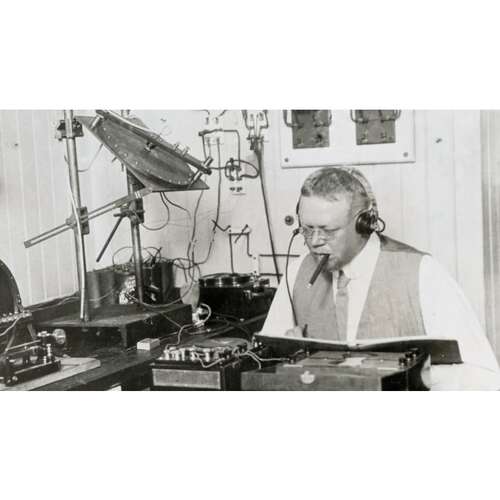
Source: Link
FESSENDEN, Reginald Aubrey, teacher, electrical engineer, university professor, and inventor; b. 6 Oct. 1866 in East Bolton (Austin), Lower Canada, eldest son of Elisha Joseph Fessenden, a Church of England deacon, and Clementina Trenholme*; m. 21 Sept. 1890 Helen May Trott (d. 1941) in New York City, and they had one son; d. 22 July 1932 in Hamilton, Bermuda.
On his father’s side Reginald Aubrey Fessenden was descended from New England Puritans and United Empire Loyalists. His mother, later a prominent member of the imperialist movement, was the granddaughter of immigrants from Yorkshire, England. In 1867 his father was ordained to the priesthood, and afterwards the family moved regularly as Elisha Fessenden assumed pastorates in Bolton Centre, Que., and in Albion, Fergus, and Clifton (Niagara Falls), Ont., before finally settling in Chippawa, near Niagara Falls. Later in life Reginald would attribute his success as an inventor to his ancestry and his Canadian upbringing. Convinced that an aptitude for invention was both racially determined and heritable, he suspected that Ontario’s Grand River valley, where he spent part of his childhood and where Thomas Alva Edison and Alexander Graham Bell* had conducted early experiments, enjoyed a climate ideally suited to inventiveness. One of Fessenden’s early influences was his uncle Cortez Smith Fessenden, a physics teacher and author living in Peterborough, and the two would remain in contact for many years after Reginald left the country. His mother clearly had an effect on his politics; long after he settled in the United States he remained a professed believer in the idea of Greater Britain, a closer union of Britain and the colonies in which its subjects had settled. Two years before his death he would pen a pamphlet entitled The founding of Empire Day … (Hamilton, Bermuda, [1930?]), which highlights his mother’s achievement in having the annual celebration of imperial patriotism officially recognized.
Fessenden received his early education at DeVeaux College in Suspension Bridge (Niagara Falls), N.Y., and in 1877 he entered Trinity College School in Port Hope, Ont. In the autumn of 1884 he matriculated at his father’s alma mater, Bishop’s College, in Lennoxville (Sherbrooke), Que., and while there he taught mathematics and other subjects at Bishop’s College School. He withdrew from the college for financial reasons after only one year and, in search of employment, he took up the headmastership of the Whitney Institute, a middle school in Smith’s Parish, Bermuda. He would maintain ties to the country of his birth, returning to visit his family and to undertake a number of short-term consultancies. For some years during the 1890s he would provide a scholarship in mathematics at Trinity College School, and in his correspondence with Trinity’s headmaster, Charles James Stewart Bethune, he confided his distaste for the United States. However, he would never return to live permanently in Canada.
In 1886, after only a year in Bermuda, Fessenden moved to New York in search of employment opportunities. He worked briefly as a journalist before being engaged by one of Thomas Edison’s companies to assist in laying electrical lines in the city. Despite being an autodidact with no formal training in applied science or engineering, at the end of that year he was appointed head chemist at the Edison laboratory in West Orange, N.J. There he began a significant professional collaboration and personal friendship with Edison’s chief electrician, Arthur Edwin Kennelly. Fessenden and Kennelly investigated the cohesion and elasticity of various materials, seeking to develop a non-flammable insulation for electrical wire. Edison’s financial problems cut short Fessenden’s research, and in 1890 he went to work for the United States Company, a division of Edison’s major competitor, the Westinghouse Electric Company, where he continued his research on cohesion and elasticity.
Fessenden remained with Westinghouse until 1892, when he became the first professor of electrical engineering at Purdue University in West Lafayette, Ind. In 1893 he accepted a position as professor of electrical engineering at the Western University of Pennsylvania in Allegheny City (Pittsburgh). His former employer, George Westinghouse, had played a significant role in securing Fessenden’s appointment, recommending him to the university and retaining his services as a consultant to contribute to his income and entice him to move.
Fessenden’s research interests while at Purdue and Western were diverse, encompassing X-rays and microphotography as well as electricity. In 1899 he invented a means of detecting sharpshooters who used smokeless powder; this technology aroused the interest of the United States army, which ordered the necessary goggles and field glasses for testing on the battlefield in the Philippines during the Spanish–American War. Most significantly, during this period Fessenden developed an interest in telegraphy, both traditional and wireless, and corresponded extensively with Irish physicist George Francis Fitzgerald about the generation and reception of Hertzian waves.
In the spring of 1900 Fessenden left academe and, thereafter, according to his wife, “invention became his profession.” Under the auspices of the United States Weather Bureau, which was seeking a method of communicating weather bulletins to ships at sea, he began experiments in Maryland, and the following year in North Carolina, into the transmission of the human voice by means of amplitude modulation (AM). He believed that several improvements on existing radio apparatus were necessary. During his two years with the bureau he developed the hot-wire barretter, which allowed for the tuning of radio transmissions, and the high-frequency alternator, which generated radio waves at frequencies of 80 to 100 kilohertz. As well, he discovered the principle of heterodyning, the interaction of signals produced by the receiver and transmitter that creates the audible beats necessary for the reproduction of voice. Fessenden achieved the first transmission of voice over radio in December 1900, and by 1902 he claimed to have transmitted musical notes between Hatteras and Manteo, N.C., a distance of about 50 miles. A dispute with bureau chief Willis Luther Moore, who sought control of his patents, led to his resignation in September 1902, and to his formation, with Pittsburgh capitalists Thomas H. Given and Hay Walker, of the National Electric Signalling Company in November. This business relationship would last only a few years, but in the short term the arrangement allowed him to continue his research. In 1908, before the American Institute of Electrical Engineers, he would recount that by the end of 1903 he had obtained “fairly satisfactory speech,” though with considerable interference; he added that by the autumn of 1906 he was transmitting over a distance of 25 miles. On 11 December that year he demonstrated the practicability of integrating wireless telephony into the telephone system. Wireless telephony, he argued, would be of particular use to small, independent telephone companies since it would allow them to compete in the long-distance market with the monopoly of Bell Telephone without having to invest in expensive lines and rights of way. In November and December 1906 he successfully transmitted “telephonic speech” across the Atlantic Ocean between a station in Machrihanish, Scotland, and the laboratory he had established in Brant Rock (Marshfield), Mass., in the summer of 1905.
Fessenden had made his only direct contribution to the development of Canada between 1903 and 1906 as the technical member of the Ontario Power Commission. The commission, with Elias Weber Bingeman Snider* as its chairman and Adam Beck* as one of its members, was organized in 1903 by a consortium of southern Ontario municipalities to investigate the feasibility of establishing a municipally operated hydroelectric facility at Niagara Falls. Much of the technical assessment of the project was subcontracted to Robert Alexander Ross and Henry Holgate of Montreal, but Fessenden did provide a series of special reports on the project. At best ambivalent about the public ownership of electrical utilities, he nevertheless supported the proposed development. He also dismissed the concerns of those who wished to preserve the falls for their aesthetic value, arguing that failure to develop the site was tantamount to a tax on the citizens of Ontario and New York State, who should benefit from the cheap hydroelectricity that was their birthright. For many years after the commission submitted its report in 1906 he would maintain an interest in the generation of electricity. In 1909 he returned to Canada to investigate the potential of the tides in the Bay of Fundy. Fessenden determined that a tidal-generation facility was feasible from an engineering standpoint, but the project was not pursued because of the absence of significant local demand for electricity.
By the end of the decade Fessenden’s relationship with the National Electric Signalling Company was souring. In 1911 he entered into prolonged legal proceedings against investors Given and Walker over the ownership of his patents. Fessenden characterized them as “a couple of Pittsburghers who made more or less of a business of preying on unfortunate inventors.” In 1917 the company, which had been in receivership for some years, was finally sold. Fessenden’s claims were not resolved until 1928. In the meantime, his research interests had shifted from radio transmission to submarine telegraphy and location. In 1912 he had begun a long professional affiliation with the Submarine Signal Company of Boston and, building on his earlier work with the production of radio waves through high-frequency oscillation, he developed the Fessenden oscillator for use underwater. The company immediately marketed the oscillator for telegraphy but was reluctant to capitalize on its potential for detecting icebergs and submarines. Undeterred, and apparently still a loyal British subject, Fessenden travelled to Ottawa in August 1914 to offer his services to the Canadian military, and to London shortly thereafter in an effort to interest the Admiralty in his submarine detector. Both overtures were refused. After the outbreak of World War I, he enlisted in the United States Naval Reserve Force, but he did not see active service; instead, he continued his research into submarine detection. In 1923 the Submarine Signal Company finally manufactured for sale a fathometer incorporating his oscillator. By this time Fessenden had left the company, resigning in 1921 because of a disagreement over management practices. By virtue of the fathometer and the related devices that he developed during his time with the company, he received, in October 1929, the ninth Gold Medal awarded by Scientific American (New York) for his contributions to marine safety.
Throughout the 1920s Fessenden continued to produce inventions at a prodigious rate. He developed a “talking violin” and a “talking piano,” and at the time of his death he was investigating a means of eliminating static interference from radio broadcasts. He also continued his battles to maintain control of his patents, securing a substantial settlement from Given and Walker in 1928. In addition to pursuing these endeavours, he began to study the history of the biblical world and the deluge recounted in the book of Genesis. This interest resulted in several publications, the most detailed being The deluged civilization of the Caucasus isthmus, privately published in Boston in 1923 after academic presses rejected the manuscript. In this work, and in subsequent instalments published by Fessenden in 1927 and posthumously by his son in 1933, he sought to identify biblical places with locations in the Caucasus Mountains, the purported homeland of the Hyperborean race mentioned in Greek mythology, whose inventiveness he extolled in his autobiography, released in 1925. A freemason since 1899, he also speculated about the Egyptian origins of freemasonry, using his interpretation of hieroglyphics. Amid much poorly substantiated conjecture based on biblical references and stories about the legendary island of Atlantis, his writings reiterated his views on invention, natural resources, government, and taxation. He maintained, as he had throughout his career, that the only true resource available to a nation was its inventors, who determine the means by which natural resources might be exploited. He railed against both private corporations and government agencies, which, he argued, impeded rather than encouraged invention. Some of his examples came from the careers of Edison and aviation pioneers Wilbur and Orville Wright, but much more space was devoted to his own attempts to interest government and private enterprise in his wireless and marine inventions, demonstrating his bitterness over years of legal disputes. He moved to Bermuda in 1928 and purchased an estate called Wistowe, where he died of a heart attack in 1932.
Fessenden’s contributions to the development of radio are manifest and have been acknowledged by most authorities on the topic. Elihu Thomson, the prominent American electrical engineer and industrialist, suggested that Fessenden’s work in the field of radio communication was more significant than that of Italian inventor Guglielmo Marconi. Over the course of his career, Fessenden published more than 150 scientific papers and patented some 230 inventions, mostly in electromagnetic signalling but also in fields as diverse as solar energy, book and leather production, and parking of automobiles. The invention of wireless telephony and radio have, of course, had especially profound implications for the history of Canada, in which the triumph of technology over distance is a major theme. However, Fessenden’s direct influence on the country’s development was limited to his brief involvement with the Ontario Power Commission; his connections to Canada were familial and emotional rather than professional. Although numerous authors, including Fessenden himself, have emphasized his Canadian roots, none of his significant experiments were conducted on Canadian soil, and, indeed, his only academic biographer claims him not for his native country but for North Carolina, where he pursued much of his groundbreaking work on wireless telephony. His career is thus a particularly apt illustration of author John James Brown’s 1967 thesis concerning the history of Canadian technology: that Canadian-born inventors have been forced to pursue their work outside the country, particularly in the United States, for want of facilities and financial support in their homeland.
Reginald Aubrey Fessenden’s speech at the American Instit. of Electrical Engineers, entitled “Wireless telephony,” appeared in Trans. (New York), 27 (1908): 553–629. A list of his works can be found in the biography written by his wife, H. M. [Trott] Fessenden, Fessenden: builder of tomorrows (New York, 1940). Some publications not included in the biography can be found in A new bibliography of Reginald A. Fessenden, comp. D. W. Kraeuter (Washington, Pa, 1993), which also includes information about secondary sources on his life and career. D. W. Kraeuter, The U.S. patents of Reginald A. Fessenden: a list of titles, numbers, and dates with a title index (Washington, 1990) is a compilation of his patents.
LAC, R1649-0-3 (mfm.). J. J. Brown, Ideas in exile: a history of Canadian invention (Toronto, 1967). Canadian men and women of the time (Morgan; 1898). M. L. Everette, “Reginald Aubrey Fessenden, American communications pioneer” (ma thesis, North Carolina State Univ. at Raleigh, 1972). E. A. Fessenden, The Fessenden family in America, ed. M. E. [Fessenden] Washburn ([Vestal?, N.Y.], 1971). G. L. Frost, “Inventing schemes and strategies: the making and selling of the Fessenden oscillator,” Technology and Culture (Baltimore, Md), 42 (2001): 462–88. Ontario Power Commission, Official report ([Toronto, 1906]).
Cite This Article
Forrest D. Pass, “FESSENDEN, REGINALD AUBREY,” in Dictionary of Canadian Biography, vol. 16, University of Toronto/Université Laval, 2003–, accessed December 31, 2025, https://www.biographi.ca/en/bio/fessenden_reginald_aubrey_16E.html.
The citation above shows the format for footnotes and endnotes according to the Chicago manual of style (16th edition). Information to be used in other citation formats:
| Permalink: | https://www.biographi.ca/en/bio/fessenden_reginald_aubrey_16E.html |
| Author of Article: | Forrest D. Pass |
| Title of Article: | FESSENDEN, REGINALD AUBREY |
| Publication Name: | Dictionary of Canadian Biography, vol. 16 |
| Publisher: | University of Toronto/Université Laval |
| Year of publication: | 2020 |
| Year of revision: | 2020 |
| Access Date: | December 31, 2025 |





